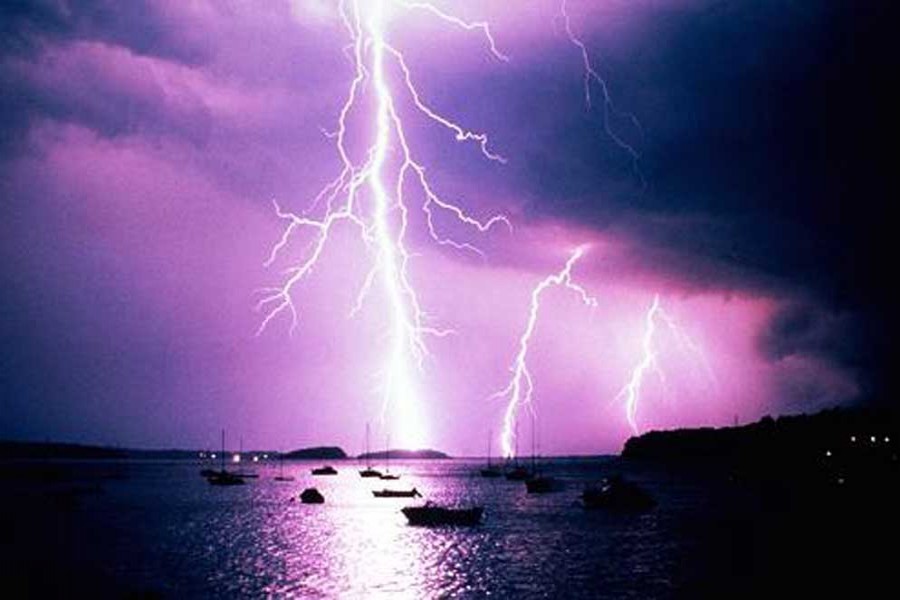The country is witnessing unusual casualties in lightning strikes ahead of monsoon this year due to change in the thunderstorm formation area along with other causes like deforestation, climate variability and global warming, said experts.
According to reports carried by different national dailies on lightning incidents, over 200 people were killed and scores of others injured in lightning strikes at different parts of the country, mainly in the central and northern parts, in the last two and a half months from March to May 17, showing an increased frequency in lightning strikes this year.
As per the website of the Disaster Management and Relief Ministry, at least 187 people died in lightning strikes at different parts of the country this year as of May 18.
At least 112 people were killed in lightning strikes in the first 10 days of this month, including 29 on May 9 alone. Besides, over 70 people were killed in March and April.
Most of the victims were agricultural workers as they were hit by lightning strikes while harvesting on or carrying paddy from open fields during storms, creating panic among farmers.
Experts, however, suggested that people should not be worried, but they need to take appropriate steps during lightning strikes and check the weather forecast before participating in outdoor activities.
They urged people to keep away from tall trees, electric pillars and towers, not to touch metals and corrugated iron, and take shelter under a concrete ceiling during thunderbolts.
"As per our record, the lightning frequency is gradually rising here during pre-monsoon period (April-May) since 1981. But we're observing greater number of fatal incidents of lightning recent years due to global warming," M Abdul Mannan, a senior a meteorologist at the Bangladesh Meteorological Department (BMD) said.
He said Bangladesh is witnessing a record number of lightning strikes this year due to the change in thunderstorm formation area. "The thunderstorm use to form in West Bengal, Bihar and joining areas in the previous years. But it's now forming near the 50 km of Bangladesh border this year, causing the fatal lightning strikes.
Mannan said districts under Dhaka Division, Rajshahi divisions and Mymensingh and some districts under Chattogram division, including Noakhali and Comilla, are experiencing increased lightning strikes this year.
BMD meteorologist Ruhul Kuddus said the country experienced excessive temperature in February and March this year which is one of the causes of rise in lightning frequency.
He also said the country's average rainfall is 22 percent higher than the normal this pre-monsoon season as Cumulonimbus clouds are gathering much this year than the previous years, increasing the lightning frequency intensity.
"Raising temperature, erratic rainfall and abnormal behavior of weather are increasing the occurrence of thunderbolt strikes," Kuddus added.
Contacted, Atiq Rahman, executive director of the Bangladesh Center for Advanced Studies, said warmer weather and climate change are causing more water evaporation from the land and ocean, increasing Cumulonimbus cloud which is generating fatal lightning strikes.
Besides, he said, deforestation and indiscriminate felling of tall trees in rural areas are also contributing to increasing lightning strike intensity.
Atiq Rahman said the government needs to carry out vigorous campaign to make people aware of lightning preparedness.
Mentioning that tall trees can absorb many of the lightning strikes, he hailed the government's steps to plant 1 million palm trees across the country to avert deaths occurring from lightning strikes. "People should also plant tall species of tree in a great number in their respective areas as the frequency of lightning is growing, reports UNB.
Ainun Nishat, Professor Emeritus of BRAC University, and water resource and climate change specialist, said the lightning frequency is becoming severer during the pre-monsoon time due to the increased amount of warm moist air over the atmosphere. "The frequency of lightning is intensified in recent times in Bangladesh and we think it is happening for growing environmental imbalance and global warming."
He suggested launching awareness campaign about lightning and strengthening warning system and network to reach the warning messages to people to reduce lightning strike casualties.


